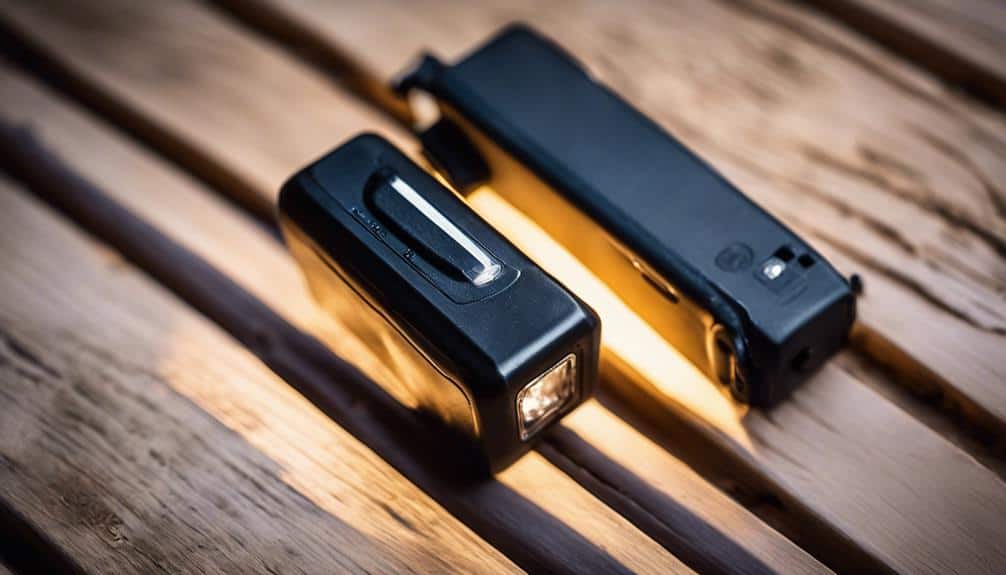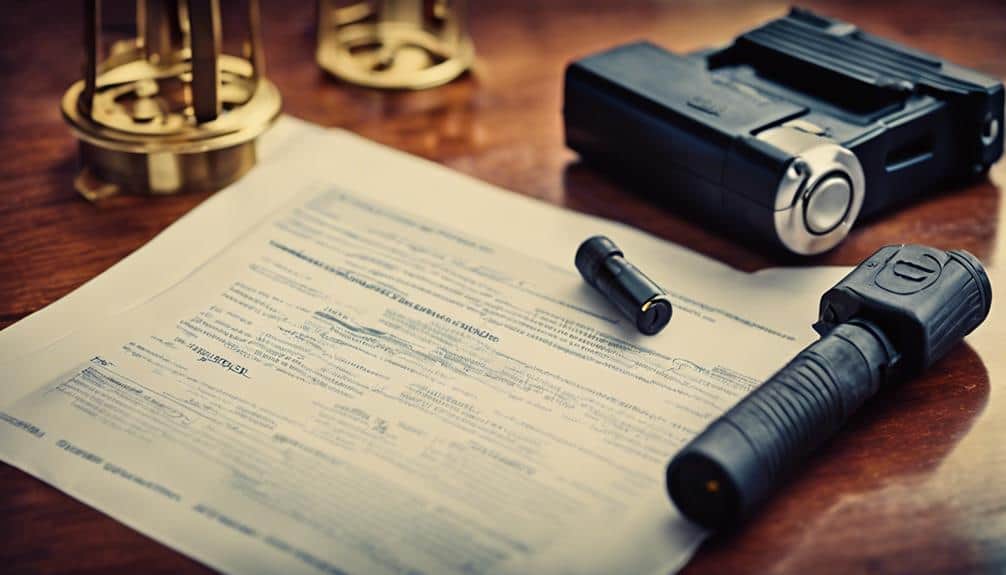Handheld stun guns are surprisingly effective
self-defense tools, with reliability jumping from 60% to a whopping 92% when you keep it activated for about five seconds. They work by delivering
electrical currents through two electrodes, causing pain and disorientation—think of it as a jolt that’ll have an attacker reconsidering their choices! While they’re easily portable and often cost under $25, it’s essential to know they only work at close range. Plus,
legal regulations can vary, so you’ll want to double-check your local laws. Stay tuned, because there’s plenty more to uncover about maximizing your safety!
Overview of Handheld Stun Guns
Understanding how
handheld stun guns work can help you assess their effectiveness as a
self-defense tool. These self-defense devices emit
electrical currents through direct contact, causing
pain and disorientation to anyone on the receiving end. You’ll need to get close to your attacker for them to work, which can be a bit nerve-wracking, but think of it as a high-stakes game of tag—only you’re armed! Many modern models, like the
FANG Keychain Stun Gun, provide a
compact design with an internal
rechargeable battery for convenience. Reliable stun guns, like those from SABRE, typically produce at least 1.0 microcoulombs, while the National Institute of Justice sets the pain threshold at 0.5 microcoulombs. Research shows that these stun guns have a
reliability of 60%, but with a solid five seconds of contact, that number jumps to an impressive 92%.
They’re portable and affordable, often under $25, and you won’t have to deal with pesky replacement cartridges like you would with TASERs. However, keep in mind that they might not incapacitate determined or drug-influenced attackers. Always check your local laws regarding usage, and remember,
situational awareness is your best friend in
personal safety! So, arm yourself with knowledge and stay safe out there!
Mechanism of Action
Handheld stun guns work by delivering
electrical currents through two electrodes that make contact with the target’s skin. When you pull the trigger, the device emits a jolt of electricity, designed to
stun and disorient anyone in close proximity—typically within just 2 inches. This electrical charge primarily affects the skin and superficial muscle mass, causing
temporary incapacitation. Many models, such as the
Fang Keychain Stun Gun, also include
additional features like a flashlight for added utility in emergencies. However, it’s worth noting that the
effectiveness hinges on delivering a sufficient electric charge; research shows you need at least 0.5 microcoulombs to induce pain effectively
a variety of stun gun options.
Using a stun gun like a TASER can be effective, but you’ll want to keep it activated for about 5 seconds to really
maximize its impact—doing so can boost effectiveness rates from 60% to a whopping 92%! Just remember, while the goal is to incapacitate, some individuals might react with increased aggression instead. So, if you’re ever in a situation where you need to use one, you might want to keep a
safe distance, just in case! After all, it’s better to be a bit shocked than to be shocked and sorry!
Effectiveness in Real Situations
In real-life confrontations, the effectiveness of
stun guns can be
unpredictable and often hinges on various factors. Unlike pepper spray, which you can deploy from a distance, stun devices require you to be uncomfortably close to your attacker. This can be tricky, especially if you’re facing someone determined or under the influence of drugs. For instance, the
40 million volts of electrical power provided by devices like the Stun Pen Pink Stun Gun can enhance the chances of
incapacitating an assailant, but maintaining control is key. Research shows that while stun guns have a
reliability rate of about 60%, this jumps to 92% if you can keep the device
activated for five seconds—definitely a strategy that calls for a steady hand!
However, the U.S. Department of Justice found that 15% of
injuries to officers were linked to stun gun use, revealing just how unpredictable these situations can get. Studies show that over
half of the time, stun devices don’t incapacitate the target, which is a bit disheartening for anyone relying on them for self-defense. Remember to evaluate the laws in your state regarding stun gun usage, as legality can vary widely. So, while stun guns can be effective, it’s wise to think of them as a
backup option, rather than your first line of defense against an aggressive threat!
Comparing Stun Guns and TASERs
When comparing
stun guns and
TASERs, you’ll often find distinct differences that can greatly impact their effectiveness in self-defense situations. Stun guns, like the
ZAP Blast Knuckles Extreme Stun Gun, require you to be
up close and personal with an assailant, delivering an electric shock upon contact with
950,000 volts of stun protection. On the other hand, TASERs let you keep a safe distance,
incapacitating targets from up to 15 feet away with their projectile darts. This range is a game changer, especially when nerves kick in during stressful encounters.
TASERs work by inducing
neuromuscular incapacitation, affecting larger muscle groups and rendering an attacker temporarily powerless. Stun guns, while they can cause localized pain and disorientation, only have a reliability rate of about 60%. However, if you keep the pressure on for five seconds, that jumps to 92%.
In terms of cost, stun guns are your
budget-friendly option, often priced under $25, while TASERs can set you back $400 or more, plus extra cartridges. So, whether you’re a civilian looking for
personal safety or an enforcement agency considering options, understanding these differences is essential. You wouldn’t want to bring a stun gun to a TASER fight, right?
Legal Considerations and Safety
Understanding the
legal landscape surrounding
stun guns is vital for anyone considering these self-defense tools. While
49 out of 50 states in the US permit their use, exceptions exist, like in
Rhode Island, where
regulations can be stricter. You need to familiarize yourself with your state’s stun gun laws, including
ownership,
carry permits, and usage guidelines, to avoid any legal repercussions. After all, you don’t want your attempt at non-lethal self-defense to land you in hot water! It’s also important to know that certain models, such as the
FANG Pink Stun Gun, are designed with compact sizes for easy concealment, which may influence your decision based on state regulations.
Improper use of stun guns could lead to serious consequences, including
assault charges—definitely not the kind of surprise you want. It’s also essential to stay updated on any changes in legislation, as laws can shift with public sentiment or local ordinances. Before making a purchase, double-check the specifications of your chosen model, because some might not be permissible in your area. Remember, being
well-informed makes you a savvy consumer and helps guarantee you’re using your stun gun legally and safely. So, equip yourself with the right knowledge, and you’ll be ready to defend yourself while staying on the right side of the law!
Frequently Asked Questions
How Effective Are Handheld Stun Guns?
In self-defense, think of a stun gun as a lightning bolt—powerful yet unpredictable. Its effectiveness varies based on usage techniques, electrical safety, and legal regulations, but effectiveness studies suggest it’s a valuable personal protection tool.
A stun gun can stop an attacker in self-defense applications, but its effectiveness varies. You need user training and awareness of legal restrictions and electrical safety to guarantee it’s a viable option for personal safety.
Which Is Stronger, a Taser or a Stun Gun?
In a world where knights wielded swords, choosing between a taser and a stun gun means weighing taser range against stun gun voltage. For self-defense effectiveness, consider their safety features and legal regulations in various usage scenarios.
Does a Stun Gun Penetrate the Skin?
A stun gun doesn’t penetrate the skin; it delivers an electric shock that affects skin resistance. When considering stun gun safety, remember pain threshold varies, impacting its effectiveness as a self-defense tool amid legal considerations.








4 Responses